Physical Address
304 North Cardinal St.
Dorchester Center, MA 02124
A rare dermal or subcutaneous benign lesion composed of disordered mature elements, including skeletal muscle, adipose tissue, nerve bundles, blood vessels, adnexal tissue, and collagen
Initially reported as striated muscle hamartoma
Additional terms used in the past include congenital midline hamartoma and hamartoma of cutaneous adnexa and mesenchyme
Could reflect abnormalities in the migration of mesoderm during embryogenesis
Slight male predominance
Most cases are congenital or discovered during infancy or early childhood
Rarely diagnosed in young adults
Mostly sporadic but may occur as part of a syndrome such as Goldenhar (oculoauriculovertebral) and Delleman (oculocerebrocutaneous) syndromes
Other associated conditions include persistent thyroglossal duct, amniotic band syndrome, spinal dysraphism, cleft lip, and cleft gum
Majority of cases discovered incidentally
Solitary lesions by far predominate (over 80%)
Size ranges from a few millimeters to 2 cm
Skin-colored papule, nodule, pedunculated lesion, or mass, exceptionally as an atrophic plaque mimicking morphea “en coup de sabre”
The head and neck area is the most common affected location, particularly the periorbital and perioral regions
Rare cases described in perineal area, vagina, digits, oral cavity, and nares
Benign lesion
Cured by total surgical excision
No recurrences documented
An instance of complete spontaneous regression reported
Subcutaneous or dermal lesion with spared overlying epidermis
Proliferation of mature skeletal muscles with regular cross-striations arranged in bands, single muscle fibers, or haphazard fashion
Additional components in variable proportions include
Mesodermal tissue: mature fat, elastic fibers, collagen, blood vessels, arrector pili muscles
Ectodermal tissue: eccrine glands, pilosebaceous units, vellus hair follicles, nerves
Calcification or ossification rarely seen
The skeletal muscle component expresses desmin, myoglobin, and myogenin
Accessory tragus
Rhabdomyoma
Rhabdomyosarcoma
Nevus lipomatosis superficialis
Fibrous hamartoma of infancy
Infantile myofibromatosis
Neuromuscular choristoma
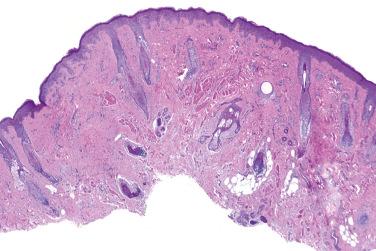
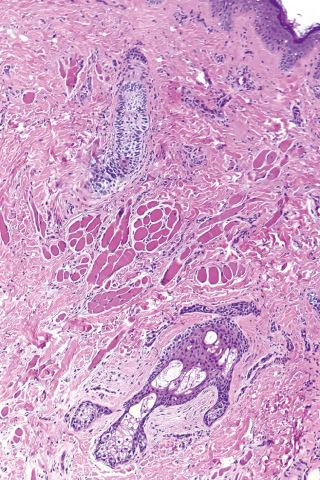
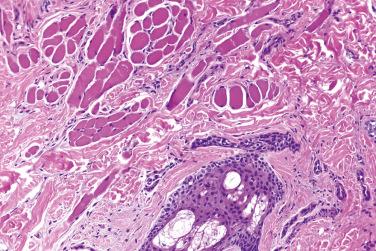
An uncommon benign tumor of either mature (adult type) or immature (fetal type) striated skeletal muscle arising in the dermis or subcutaneous tissue
Cutaneous lesions are divided into
Adult type: more common; affects the head and neck of middle-aged or elderly males
Fetal type: most commonly located at the periorbital, periauricular, and perioral areas of male infants
Slowly growing, painless, solitary
Small nodular or lobulated mass
Periorbital lesions present with proptosis
Size ranges from 0.5 to 10 cm
Benign tumor
Cured by complete surgical excision
Recurs only if incompletely excised
Well-circumscribed, nonencapsulated, subcutaneous tumor composed of variable proportion of large polygonal cells with abundant eosinophilic cytoplasm and small, round or spindle-shaped cells
Intracytoplasmic crystalline, rodlike inclusions may be seen
Cytoplasm may be vacuolated (spider cells)
Small, round vesicular nuclei with prominent nucleoli
Adult rhabdomyoma
Mainly large and polygonal cells with abundant eosinophilic cytoplasm
A scant stroma
Mitoses absent or rare
Intracytoplasmic crystalline, rodlike inclusions (corresponding to the Z-lines) are commonly seen
Fetal rhabdomyoma
A predominance of immature, round to spindle-shaped rhabdomyoblasts with a wide spectrum of skeletal muscle differentiation
Cross-striation in the cytoplasm of skeletal muscle fibers usually present at the periphery of the tumor, consistent with maturation of lesional cells
A variably myxoid stroma
Variation in cell size and shape without prominent atypia
Mitoses can be frequent
Necrosis is usually absent
A cellular variant is recognized
Tumor cells express desmin, myogenin, and muscle specific actin
Vimentin, S100 protein, and smooth muscle actin are less commonly positive
The adult type
Muscle cell differentiation with actin and myosin bundles
Cytoplasmic glycogen and crystalline rod-shaped inclusions
The fetal type
Muscle cell differentiation with actin and myosin bundles
Rod-shaped cytoplasmic inclusions are less common
Undifferentiated spindle cells also seen
Rhabdomyosarcoma
Granular cell tumor
Hibernoma
Infantile fibromatosis
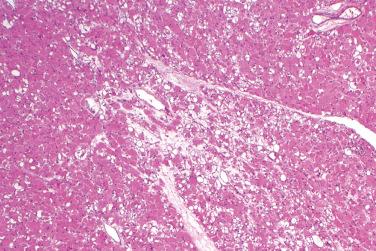
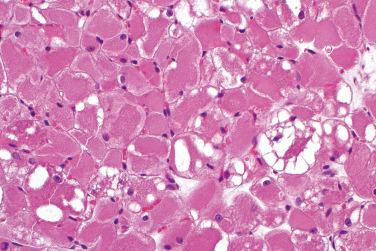
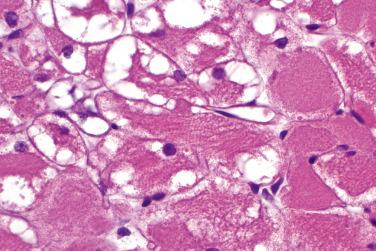
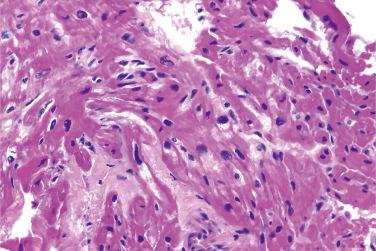
A malignant mesenchymal tumor with predominant primitive cell morphology and evidenced skeletal muscle differentiation
Primary cutaneous tumors that arise in the dermis or subcutaneous tissue and lack deep soft tissue involvement are extremely rare
Become a Clinical Tree membership for Full access and enjoy Unlimited articles
If you are a member. Log in here